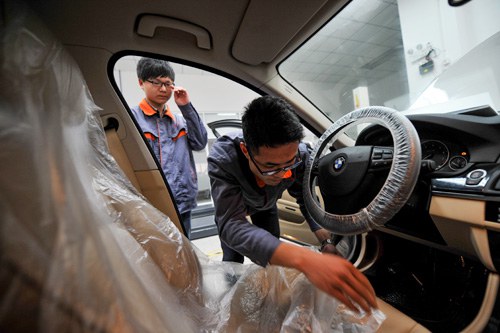|
 |
|
REAL EXPERIENCE: Two students from a vocational school in Zhuzhou of central China's Hunan Province attend on-site training at a local BMW training base on April 2 (BAI YU) |
Chinese education authorities have recently revealed that they will soon unveil the planned reform of the National College Entrance Examination, known as gaokao, which combines the current vocational training system with academic higher education.
Lu Xin, Vice Minister of Education, made the announcement at the 2014 China Development Forum in Beijing on March 22. She said that under the new gaokao system, technical capability and academic aptitude will be examined by two separate testing models.
Under the first model, a new syllabus will assess a combination of the candidates' technical skills and textbook knowledge, with the aim of serving students who seek to enter into vocational professions, such as those wanting to become engineers, senior mechanics and high-calibre laborers.
The second model of examination, which is currently the form practiced throughout the country, will only test textbook knowledge and be suited to academically inclined students, according to Lu.
"This will enable students to make career choices at the age of 16, when they are still in high school," she said. "Teenagers can realize their life goals based on their own choices."
Under the current system, potential college students can only choose their majors after they pass a uniform gaokao, which thwarts the hopes of higher education for those who are especially talented in certain technical fields but not good at taking exams.
Tang Shengchang, a member of the National Education and Examination Steering Committee and former President of Shanghai High School, said that he is delighted to see the change, as it will bring positive and long-term improvements to the country's pool of talent.
"The reform will allow both vocational students and academic students to enter into high-quality higher education," he said.
A valid option
Education experts say the upcoming reform also reflects China's need for more highly skilled workers in both its hi-tech industries and those which are becoming more sophisticated such as construction and manufacturing.
Statistics from the All China Federation of Trade Unions show that the country has a shortage of 22 million-33 million skilled workers. "China is suffering from both an extremely short supply of technical talent and a shortage of jobs for college students," Xinhua News Agency reported.
Every year, there are about 17 million high school and college graduates entering China's labor market, according to data from the Ministry of Education.
Under these circumstances, developing a strong vocational education system becomes one of the main solutions to the predicaments in the labor market, according to Ding Dajian, a researcher with the China Institute for Employment Research under the Beijing-based Renmin University of China.
At the same time, Ding pointed out the labor problem facing the country.
Currently, the phrase "technically inclined students" mainly refers to students from vocational high schools. Most of them will start looking for a job after graduating from high school. Only a small number of them seek further education in advanced vocational schools.
"For a long time, education in China has focused on academic learning because people only regard this kind of education as 'real' learning. People don't pay enough attention to skill training, especially in basic education," Tang with the National Education and Examination Steering Committee said.
"This has resulted in the country's disadvantage when it comes to industrial techniques. For example, our architectural design is as good as other countries', but our manufacturing and construction techniques still have a lot of room for improvement," he said.
Ding suggested changing the public's perception of vocational education. "There is neither lowliness nor nobleness in education. Vocational education is just a specific type of education, and it is equally important as academic education," he said.
In order to elevate the reputation of vocational education, Ding suggested reevaluating the current rating system for educational institutes to make vocational training schools equal with colleges.
| 